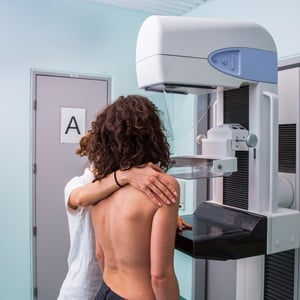
These statistics have been challenged, and not in the way we'd like. Professor Justus Apffelstaedt, associate professor at the University of Stellenbosch and head of a multidisciplinary breast health centre, says: "Current statistics are thought to underestimate breast cancer incidence by a quarter to a third." He suggests poor infrastructure and methods of collecting data lead to under-reporting.
There has, however, been good news on the treatment front, with lower mortality rates and less intrusive therapies, including hormone treatment, chemotherapy and biologic therapies. What hasn't changed, is that the effectiveness of treatment is to a large extent dependent on early detection.
Mammography and technology
The easiest and most cost-effective way to detect abnormalities in the breast, is with a mammogram. Basically, it's an X-ray of the breast tissue and has been around in one form or another since 1913.
Digital mammography is replacing the familiar form, film screen mammography, meaning film and chemicals are giving way to computers and software. "In conventional mammography, once the image is taken, that's it. If there is any problem, another image will have to be taken. In digital mammography, you can manipulate the image, changing contrast levels and brightness; you can enlarge parts of the picture or even invert the picture, changing black to white and vice versa," says Apffelstaedt.
"Digital images can also be subjected to computer-assisted detection. A computer identifies suspicious areas and alerts the doctor to potential trouble spots."
Digital mammography has been shown to improve cancer detection in women with dense breasts, women below the age of 50, and premenopausal women.
"Digital mammography has further advantages in that it reduces the radiation dosage by about half, and the time required is less than half of that for conventional mammography," says Apffelstaedt.
Frequently asked questions
Apffelstaedt says the answers to some common questions are:
Is chemotherapy the best way to treat breast cancer?
A multidisciplinary approach that combines a number of treatment options that include surgery, radiation, chemotherapy, and hormonal and biologic agents is most effective.
Does smoking increase your risk of breast cancer?
Breast cancer is one of the few cancers where risk is not increased due to smoking.
Are all mammograms the same?
The accuracy of mammographic diagnosis in screening, which forms the bulk of all mammography performed in South Africa, is dependent on:
- Optimal equipment used to produce the mammogram – these days full-field digital mammographic equipment is regarded as best.
- The optimal image as produced by a radiographer specialised in mammography.
- The optimal reading of the image is usually provided by doctors who specialise in breast imaging and who have possibly received overseas training in mammography interpretation.
- A process of rigorous quality control, where all outcomes are recorded and regularly analysed.
Where all of these conditions are met, the promise of lowering the mortality rate of breast cancer and the increase in breast conservation are likely to be realised.
Does it make a difference where you are treated?
It has been shown the risk of death within five years can be up to 60% higher in environments where only a few breast cancer cases are treated versus environments where more than 150 breast cancers are treated per year.
Is it better to remove the entire breast than conserving it?
The tumour in the breast will not kill you – the spread of the cancer to the brain, lungs etc. will. As breast cancer often spreads early in the course of the disease, a mastectomy (breast removal) will not guarantee you better survival.
Are mammograms painful?
If the breasts are painful, a mammogram should not be done until the reason for the tenderness has been addressed. Well-trained mammographers should be able to help you relax. When you are relaxed, the pectoral muscles behind the breast relax, which should result in a painless mammogram.
Are you at higher risk of developing breast cancer if you've had breast augmentation?
Breast augmentation (the procedure where breast size is enlarged) does not constitute an increase in glandular tissue, therefore you are not at greater risk. It is necessary that an experienced mammographer takes your mammogram, though, as special techniques are needed to reveal all breast tissue.
Sources: Cancer in South Africa, 1998 – 1999; National Health Laboratory Services.
Wilma Stassen, Health24, December 2007




 Publications
Publications
 Partners
Partners











